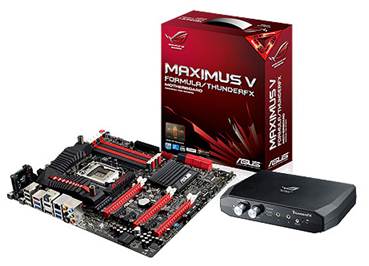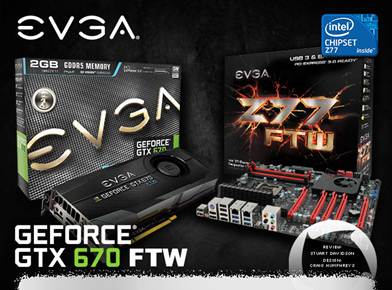When you absolutely have to have the fastest
PC in the room, accept no substitutes
While the vast majority of us plump for
sensible hardware at sensible prices there are others whose ideal PC is a bank
balance-destroying electricity bill-mangling giant of multi-GPU engineering.
This review then is the latter, as we pi t two of the most premium Z77 boards
against each other-the Asus Maximus V Extreme and EVGA Z77 FTW.

ASUS
Maximus V Extreme and EVGA Z77 FTW
The Extreme is the larger at 305mm x 272mm
and, as Asus’ current flagship board, it’s stuffed with extras to complement
the Z77 chipset. Alongside the two large banks of VRMs and accompanying
aluminum heartsick, the Extreme sports five PCI-E graphics slots, running one
at 16x or five at 8x. These slots are connected to a PLX splitting chip beneath
the backlit Republic of Gamers logo, which enables the board to support up to
4-way SLI and CrossFireX. There's also a single 1x PCI-E 2 slot, but this is
blocked if you opt for a 4-way SLI dual-slot GPU setup.
Elsewhere, there are on-board power and
reset buttons, a POST code reader, a dual BIOS arrangement with an on-board
switch and a raft of extras for professional over clockers. These range from
Asus' Subzero Sense ports, which enable you to accurately monitor system
temperatures when cooling with LN2, to a VGA hotwire array of
pin-outs for soldering on your own voltage regulators. These aren't
particularly useful features unless you have a can of LN2 on hand
though.
More practical is a set of PCI-E debug
switches, with which you can enable and disable PCI-E slots. There are also
on-board Wi-Fi and Bluetooth, and the inclusion of Asus' OC-Key. The OC key is
particularly handy, connecting to your DVI output and displaying a visual
overlay showing real-time clock speeds and temperatures.
The Extreme is also the first board we've
seen with Intel's Thunderbolt port. Its peak bi-directional speed of 10Gb/sec
(1.25GB/sec) and ability to daisy-chain both display and storage devices makes
it an intriguing proposition, not one that's essential yet.
There's also the requisite truck-load of
USB and SATA ports. The rear I/O offers four USB 3 ports and four USB 2 ports,
with an extra four of each available via on-board headers in the board's lower
right-hand corner. Asus has expanded on the usual four SATA 3Gbps and two SATA
6Gbps ports of the Z77 chipset too, with an ASMedia controller offering an
additional (albeit slower) four SATA 6Gbps ports. There's also an mSATA
connection via a daughterboard connected at the top of the rear I/O pane, below
which you'll find a CMOS reset and BIOS flashback switches.
As Asus' designated 'bonkers board' (not an
official title), the Extreme also carries extra power connectors. The 8-pin
EPS12V connector is joined by an optional 4-pin connector, while a 6-pin PCI-E
connector sits above the expansion slots for multiple graphics cards.
Basically, it’s the most comprehensively featured board we’ve handled to date.

In comparison, EVGA’s Z77 FTW offers fewer
features, but still distinguishes itself as a super-high-end board.
Instead of using a wraparound array of
VRMs, the Z77 FTW's single large bank sits to the left of the CPU socket,
cooled via a single large aluminum heartsick.
It too sports five full-sized 16 x PCI-E3
slots, running with either one slot at 16x, or five at 8x. There's also a
single 1x PCI-E 2 slot but, as with the Asus, this is blocked if you kit out
the board with the full complement of four dual-slot graphics cards.
On-board extras include a triple-BIOS
switch, power, reset and CMOS-clear buttons, a POST code reader that doubles as
a CPU temperature readout, and an actively cooled chipset, courtesy of a
low-profile 40mm fan. There's also a handy array of switches for
enabling/disabling the PCI-E slots-useful for troubleshooting multi-GPU setups
- and an array of voltage read-out pins above the DIMM slots.
Looking to the rear of the board, the EVGA
has six USB 2 ports and four USB 3 ports (with another four USB 2 and two USB 3
ports available via no-board headers), alongside a pair of eSATA ports powered
by a Marvell controller. Dual Marvell 1 Gb/sec Ethernet ports (compared to the
Extreme's single Intel 1 Gb/sec port) and a CMOS reset switch are also useful
additions. Meanwhile, on-board display output is handled by a single miniDisplayPort connector
The Z77 FTW also boasts lots of additional
power connectors for use when extreme overclocking or if you use multiple
graphics cards. Next to the 8-pin EPS12Vconnectoris an optional 8-pin
connector, and there's a pair of 6-pin PCI-E connectors at the top and bottom
of the bank of PCI-E slots too. As an extra neat touch, the 24-pin ATX
connector is also equipped with a 90-degree adaptor, helping to make that
top-end build look even neater.

While both boards are loaded with extras to
deal with even the pickiest of demands, it's clear that the Extreme is the
better equipped of the two, with Thunderbolt, WiFi and Bluetooth being the most
practical advantages. For those considering a 4-way SLI setup, the Extreme is
also the only one of the two to include a 4-way SLI bridge, with the Z77 FTW
only bundling dual-card and triple-card bridges.
Performance
Fitting our test Intel Core i7-3770K in
each board, we found the Z77 FTW had an immediate disadvantage at stock
frequencies, as its CPU only Turbo Boosted to 3.7GHz when all four cores were
loaded, while the Extreme boosted to 3.9GHz regardless. This saw the Extreme
return an overall score in our Media Benchmarks of 2,399 points, compared to
the Z77 FTW's 2,265. In Crysis 2, there was no such gap, though, with both
boards producing a playable minimum frame rate of 26fps.

Overclocking performance is the important
aspect for high-end boards, though, and we first turned our attentions to the
Extreme. Asus' EFI has now matured, so overclocking the Extreme was
straightforward. Clock speed multiplier and voltage adjustments are all closely
grouped, and we had little trouble reaching our test CPU's maximum of 4.8GHz.
To do this, we disabled Intel C-states, used a multiplier of 48x and a base
block of 100MHz, set Load Line Calibration to 'Ultra High' and the CPU voltage
to 1.33V.